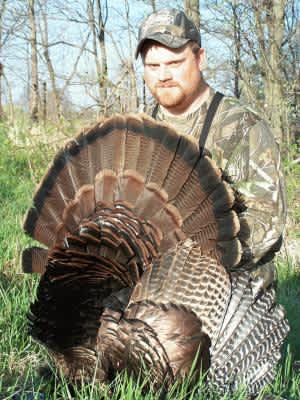Know a Bird to Kill One
Joe Martino 04.14.14

We have all been there: you’re all amped up as the hens talk and the gobblers fire off from the roost, and you seem to be in the perfect position right in the middle of the action, feeling fairly certain that in a matter of minutes you will be draping a pair of ankles over your shoulder. But instead of the scene that played out in your head, the turkeys all flew down and wasted no time spreading the distance between you and them while the toms simultaneously fell silent.
You’ve made one big misstep: you didn’t do your due scouting diligence prior to your hunt.
Scout for your bird
Too many turkey hunters simply think that being in the roost area is enough to kill a gobbler. While once in a while this can be true, to be consistent on punching your turkey tag, it usually takes a lot more than that. Scouting is just as important for turkey hunting as it is for deer hunting. There is no substitute for understanding your quarry and using that information to up your odds.
When scouting for turkeys before opening day, I like to keep it fairly simple. Actually getting in and covering a lot of ground looking for sign is not how I go about it prior to the opener. I do not want to spook any birds in their daily routine—such an incident may cause them to change their habits. Instead, your first step is to just be in a place during the mornings and evenings where you expect to be able to hear the toms gobbling from the roost and listen. Once you have found roost sites, try to keep an eye or ear on the birds after they fly down, if you can. Sometimes we tend to think that finding the roost area is good enough and leave it at that, but by knowing where the turkeys tend to go after they fly down, you will significantly increase your chances of killing one. So either stay put and keep listening for gobbling and hen talk as they move off, or move in the general direction as they are and try to keep tabs on them. Try to do so without being detected.
By knowing their favorite haunts, you will not have to rely on that fleeting 30 half hour of activity at daylight to try to fill your tag. You will know where to go and be in a position to intercept the birds later on in the morning, and that is a good thing. Or, if there is no gobbling on a given day, you will know which areas to go to so you can just sit and wait them out if you have to. If you have scouted properly, sooner or later, they will show up.
Keep your turkey calls at home
Practicing your calling is important (and, yes, it is fun) so that you can masterfully replicate the sounds of the wild turkey at game time. However, practicing your calling on live birds beforehand is never a good idea. Travel down any back road a couple of weeks before turkey season and you are sure to run into people pulling over on the side of the road and blowing on a turkey call in hopes of getting a gobbler to fire off. They do this to locate the tom and learn his whereabouts or roosting area prior to the opener. Little do they know that by doing so, they are making the hunting considerably tougher, not only for themselves, but for others as well.
Under no circumstances should you ever use a turkey call in the wild call unless you are actually hunting and intent on killing a turkey. Every time you do, you run the risk of educating the birds in your area. Let’s say you are out scouting and just cannot resist giving a few yelps to see if anything responds. Whether a gobbler does or does not fire back, if he heard it and comes in to investigate, or worse yet, notices you, then you have pretty much just eliminated that bird from your hit list. The odds are long that he will readily come into a call again this season, or if he does, he will likely come in silently.
If you just have to try to make a tom gobble, only do so with the use of calls designed to “shock” him into gobbling, rather than ones designed to draw him in. A crow call, for example, is a commonly used locator-call which is designed to pierce the air and make a gobbler gobble. It is used to locate the bird but will not entice him to come investigate, and therefore is fairly harmless when used in this manner. Be advised, though: eventually turkeys can get used to such calls and respond less to them over time.
Gobblers will tend to gobble often enough on their own for you to be able to figure out their roosting areas. They will typically continue to gobble for a while after they fly down in the mornings and slightly prior to flying up to roost the evenings, enabling you to figure out their habits without the use of calls.
Part of the excitement of the spring turkey season is getting ready for it. The anticipation and locating birds gets your blood pumping and fills your head full of dreams that keep you from sleeping at night for several days before the season arrives. Do not let this excitement spoil your chances at a longbeard this year by getting antsy and blowing your cover.
Put some time in and scout smart this year. You will be surprised at how much you learn.

